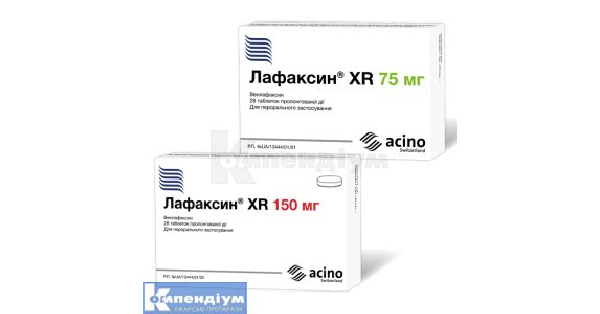

LAFAKSIN XR ASINO

Ask a doctor about a prescription for LAFAKSIN XR ASINO

How to use LAFAKSIN XR ASINO
INSTRUCTIONS for medical use of the medicinal product Esperoct (Esperoct)
Esperoct
(Esperoct)
Composition:
active substance: turoctocog alfa pegol;
500 IU
One vial of powder contains a nominal amount of 500 IU of turoctocog alfa pegol*.
After reconstitution of the preparation, 1 ml of solution contains approximately 125 IU of turoctocog alfa pegol.
1000 IU
One vial of powder contains a nominal amount of 1000 IU of turoctocog alfa pegol*.
After reconstitution of the preparation, 1 ml of solution contains approximately 250 IU of turoctocog alfa pegol.
1500 IU
One vial of powder contains a nominal amount of 1500 IU of turoctocog alfa pegol*.
After reconstitution of the preparation, 1 ml of solution contains approximately 375 IU of turoctocog alfa pegol.
2000 IU
One vial of powder contains a nominal amount of 2000 IU of turoctocog alfa pegol*.
After reconstitution of the preparation, 1 ml of solution contains approximately 500 IU of turoctocog alfa pegol.
3000 IU
One vial of powder contains a nominal amount of 3000 IU of turoctocog alfa pegol*.
After reconstitution of the preparation, 1 ml of solution contains approximately 750 IU of turoctocog alfa pegol.
Activity (in international units, IU) is determined by a chromogenic assay method according to the European Pharmacopoeia. The specific activity of turoctocog alfa pegol is approximately 9500 IU/mg protein.
The active substance turoctocog alfa pegol is a covalent conjugate of the turoctocog alfa protein with polyethylene glycol (PEG) of 40 kDa size.
* Human factor VIII produced by recombinant DNA technology on a Chinese hamster ovary cell line, without the use of any human or animal additives in this cell line, during purification, conjugation, and manufacture of the Esperoct preparation.
excipients:
powder: L-histidine; sucrose; polysorbate 80; sodium chloride; L-methionine; calcium chloride dihydrate; sodium hydroxide (for pH adjustment); hydrochloric acid (for pH adjustment);
solvent: sodium chloride; water for injection.
Pharmaceutical form.
Powder and solvent for solution for injection.
Main physical and chemical properties:
The lyophilized powder appears as a lyophilizate from white to almost white color.
The solvent is clear and colorless; pH 6.9; osmolality 590 mOsmol/kg.
Pharmacotherapeutic group.
Hemostatic agents. Factor VIII coagulant.
ATC code B02B D02.
Pharmacological properties.
Pharmacodynamics.
Mechanism of action
Turoctocog alfa pegol is a purified recombinant human factor VIII (rFVIII) with a polyethylene glycol (PEG) molecule of 40 kDa size covalently conjugated to the protein. PEG is attached to the O-linked glycan in the truncated B-domain of rFVIII (turoctocog alfa). The mechanism of action of turoctocog alfa pegol is based on replacing the deficient or missing factor VIII in patients with hemophilia A.
When turoctocog alfa pegol is activated by thrombin at the site of injury, the B-domain containing the PEG fragment and the a3-region are separated, resulting in the formation of activated recombinant factor VIII (rFVIIIa), which is structurally similar to native factor VIIIa.
The factor VIII complex with von Willebrand factor consists of two molecules (factor VIII and von Willebrand factor), which have different physiological functions. When the preparation is administered to a patient with hemophilia, factor VIII binds to von Willebrand factor in the bloodstream. Activated factor VIII acts as a cofactor for activated factor IX, accelerating the conversion of factor X to activated factor X.
Activated factor X converts prothrombin to thrombin. Then thrombin converts fibrinogen to fibrin, after which a clot can form. Hemophilia A is a hereditary, sex-linked coagulation disorder due to reduced levels of factor VIII:C, leading to profuse bleeding into joints, muscles, or internal organs, either spontaneously or due to accidental trauma or surgical intervention. Through replacement therapy with factor VIII, factor VIII levels in plasma are increased, thereby enabling temporary correction of the deficiency and counteracting the tendency to bleed.
Clinical efficacy in prevention and treatment of bleeding episodes
The clinical efficacy of Esperoct in prevention and treatment of bleeding was studied in five multicenter prospective clinical trials involving 270 patients with severe hemophilia A who had previously received treatment.
Prevention in adults/children aged 12 years and older
The efficacy of Esperoct for prevention and treatment of bleeding was evaluated in an open-label, uncontrolled study in adult patients and children aged 12 years and older with severe hemophilia A. The preventive effect of Esperoct was demonstrated at a dose of 50 IU/kg every 4 days or every 3-4 days (twice a week) in 175 patients. The mean annual bleeding rate (ABR) in adults and children aged 12 years and older who received Esperoct was 1.18 (interquartile range (IQR): 0.00; 4.25), while the ABR for spontaneous events was 0.00 (IQR: 0.00; 1.82), for trauma-related events was 0.00 (IQR: 0.00; 1.74), and the ABR in joints was 0.85 (IQR: 0.00; 2.84). When imputing missing data for patients who discontinued their participation in the study, the calculated mean ABR for all bleeding episodes was 3.70 (95% CI: 2.94; 4.66). Of the 175 adults/children aged 12 years and older who received preventive treatment, 70 (40%) patients had no bleeding episodes. The mean annual consumption of the medicinal product for prevention was 4,641 IU/kg.
Note that the data on annual bleeding rate (ABR) obtained with different factor concentrates and in different clinical trials are not comparable.
Adults/children aged 12 years and older with a low bleeding frequency of 0-2 episodes over the last 6 months and who received at least 50 doses of Esperoct were eligible for randomization into preventive treatment groups with either 75 IU/kg every 7 days or 50 IU/kg every 4 days. In total, 55 of 120 patients who met the study criteria agreed to be randomized into groups (17 patients to the 75 IU/kg every 4 days group and 38 patients to the every 7 days group). The ABR in randomized patients was 1.77 (0.59; 5.32) with every 4-day dosing and 3.57 (2.13; 6.00) with weekly prophylaxis. During the randomized study phase, nine of these patients returned to every 4-day prophylaxis. Overall, considering all parts of the extension study, 31 of 61 patients who received every 7-day prophylaxis returned to every 4-day dosing.
Prevention in children under 12 years of age
The use of Esperoct in children under 12 years of age is not recommended (see section "Children").
The efficacy and safety of Esperoct for prevention of bleeding were evaluated in an open-label, single-arm study in 68 children under 12 years of age with severe hemophilia A.
The preventive effect of Esperoct was demonstrated at a dose of 60 IU/kg (50-75 IU/kg) twice a week. The median and calculated mean annual bleeding rate in children under 12 years of age who received Esperoct twice a week were 1.95 and 2.13, respectively (95% CI: 1.48; 3.06), while the ABR for spontaneous events was 0.00 and 0.58 (95% CI: 0.24; 1.40), for trauma-related bleeding was 0.00 and 1.52 (95% CI: 1.07; 2.17), and the ABR in joints was 0.00 and 1.03 (95% CI: 0.59; 1.81), respectively. Of the 68 children under 12 years of age who received preventive treatment, 29 patients (42.6%) had no bleeding episodes. The mean annual consumption of the medicinal product for prevention was 6,475 IU/kg.
Prevention in previously untreated patients (PUPs) (children under 6 years of age)
The use of Esperoct in children under 12 years of age is not recommended (see section "Children").
The efficacy and safety of Esperoct were evaluated in a multinational, non-randomized, open-label Phase 3 study. Primary prophylaxis (on-demand treatment for bleeding episodes and/or dosing at >1 week intervals until the patient reached 20 days of exposure (DE) or 24 months of age) and preventive treatment of bleeding were evaluated in 81 previously untreated patients under 6 years of age with severe hemophilia A. Of the 81 patients, 55 patients started primary prophylaxis, and 42 of these patients then switched to preventive treatment. In total, 69 patients received preventive treatment at a dose of 60 IU/kg (50-75 IU/kg) twice a week.
The preventive effect of Esperoct in previously untreated children under 6 years of age with severe hemophilia A was demonstrated with a median and calculated mean annual bleeding rate of 1.35 and 2.27, respectively (95% CI: 1.71; 3.01).
Note that the data on annual bleeding rate (ABR) obtained with different factor concentrates and in different clinical trials are not comparable. The success rate of hemostatic response in treating bleeding episodes in 69 previously untreated patients under 6 years of age who received preventive treatment was 92.5%. The mean annual consumption for 69 previously untreated patients who received preventive treatment was 5,395 IU/kg.
During the study, 56 adverse events were reported in 43 of 81 patients, and a total of 80 serious adverse events were reported in 48 patients after administration of Esperoct.
In 31 of 59 previously untreated patients without inhibitors, a temporary decrease in incremental recovery (IR) of factor VIII was observed after exposure to Esperoct. There were 17 previously untreated patients with consecutive measurements of decreased IR, all of whom had anti-PEG IgG antibodies. A link between anti-PEG antibodies and low IR cannot be ruled out.
Clinical efficacy of Esperoct in treating bleeding episodes and on-demand use
The clinical efficacy of Esperoct in treating bleeding episodes has been demonstrated in patients of all age groups.
In the majority of cases, bleeding treated with Esperoct was of mild/moderate severity.
The overall success rate of bleeding treatment was 87.7% and 94.4% of all bleeding episodes treated with 1-2 injections.
In 12 patients aged 18 years and older who received on-demand treatment, 1,126 bleeding episodes were treated with a mean dose of 38.1 IU/kg at a mean annual consumption of 1,457 IU/kg. Of these 1,126 bleeding episodes, 86.9% were effectively treated with one injection, and 96.8% with 1-2 injections of Esperoct.
Clinical efficacy of Esperoct in perioperative use
Esperoct was effective in maintaining hemostasis during major surgical procedures, with a success rate of 95.6% in all major surgeries performed (in 43 of 45 cases, efficacy was rated as "excellent" or "good").
Pharmacokinetics.
In total, 129 pharmacokinetic (PK) profiles were evaluated after single administration of Esperoct in 86 patients (including 24 pediatric patients aged 0-12 years).
All pharmacokinetic studies of Esperoct were conducted in patients with severe hemophilia A (factor VIII level <1%) who had previously received treatment. Patients received a single dose of 50 IU/kg, and blood samples were taken for analysis before administration and at multiple time points over 96 hours after administration.
In adult patients, the half-life of Esperoct was 1.6 times longer than that of unmodified factor VIII concentrates.
Pharmacokinetic parameters
In total, 108 pharmacokinetic profiles were evaluated after single administration of Esperoct at a dose of 50 IU/kg in 69 patients. The pharmacokinetic parameters of Esperoct after single administration were comparable in young children (aged 0-6 years) and older children (aged 6-12 years), as well as in adolescents (aged 12-17 years) and adults (aged 18 years and older).
As expected, in children under 12 years of age, the increase in recovery parameters was lower, while the clearance adjusted for body weight was higher. In general, a trend towards increased recovery and decreased clearance (mL/h/kg) with age was observed. This is consistent with the fact that in children under 12 years of age, the volume of distribution per kilogram of body weight is higher than in adults (Table 1).
The pharmacokinetic parameters of Esperoct after single administration, determined after 28 weeks of preventive treatment, were consistent with the initial pharmacokinetic parameters.
Table 1 shows the pharmacokinetic parameters of Esperoct after single administration. The use of Esperoct in children under 12 years of age is not indicated.
| PK parameter, N - number of patients | Patients aged 0-6 years, N = 13 | Patients aged 6-12 years, N = 11 | Patients aged 12-18 years, N = 3 | Patients aged 18 years and older, N = 42 |
| Number of PK profiles | 13 | 11 | 5 | 79 |
| IR (IU/dL) per (IU/kg)a | 1.80 (29) | 1.99 (25) | 2.79 (12) | 2.63 (22) |
| Maximum factor VIII activity (IU/dL)a | 101.2 (28) | 119.6 (25) | 133.2 (9) | 134.4 (23) |
| t1/2 (hours) | 13.6 (20) | 14.2 (26) | 15.8 (43) | 19.9 (34) |
| AUCinf (IU*hours/dL) | 2147 (47) | 2503 (42) | 3100 (44) | 3686 (35) |
| CL (mL/h/kg) | 2.6 (45) | 2.4 (40) | 1.5 (43) | 1.4 (32) |
| Vss (mL/kg) | 44.2 (34) | 41.2 (25) | 33.4 (10) | 37.7 (27) |
| MRT (hours) | 17.0 (22) | 17.3 (31) | 21.7 (45) | 25.2 (29)b |
Abbreviations: AUC - area under the curve of factor VIII activity over time; t1/2 - terminal half-life; MRT - mean residence time; CL - clearance; Vss - volume of distribution at steady state; IR - increase in recovery.
a Recovery and factor VIII activity were determined 30 minutes after administration in patients aged 12 years and older and 60 minutes after administration (first blood sample) in children under 12 years of age.
b Calculations based on 67 profiles.
The mean steady-state factor VIII activity level in plasma during preventive treatment with Esperoct at a dose of 50 IU/kg every 4 days in patients aged 12 years and older is 3.0 IU/dL (95% CI: 2.6-3.4).
Preclinical safety data
Preclinical data indicate no special hazard for humans based on standard studies of safety and toxicity of repeated administration.
Clinical characteristics.
Indications.
Treatment and prevention of bleeding in patients aged 12 years and older with hemophilia A (hereditary factor VIII deficiency).
Contraindications.
Increased sensitivity to the active substance or to other excipients of the medicinal product (see section "Composition").
Known allergic reaction to hamster proteins.
Interactions with other medicinal products and other forms of interaction.
There are no reports of interactions between human coagulation factor VIII (rDNA) and other medicinal products.
Special warnings and precautions for use.
Monitoring
During treatment, it is recommended to regularly determine factor VIII activity levels to adjust the dosing regimen of Esperoct. In different patients, the response to factor VIII may vary, resulting in different half-life and recovery parameters. For patients with insufficient or excessive body weight, dose adjustment based on body weight may be necessary. Especially during major surgical procedures, it is necessary to monitor the replacement therapy with factor VIII by determining factor VIII activity in plasma.
Factor VIII activity in Esperoct can be determined by standard quantitative assays for factor VIII - chromogenic assay and one-stage clotting assay. When using the one-stage clotting assay, which is based on determining the activated partial thromboplastin time (aPTT), the results of factor VIII activity in patient plasma samples may significantly depend on both the type of aPTT reagent and the reference standard used in the assay.
When using the one-stage clotting assay, it is recommended to avoid using certain silicon-based reagents, as they may cause underestimation of results. Additionally, there may be significant discrepancies between the results of one-stage clotting assays based on aPTT determination and chromogenic assays according to the European Pharmacopoeia. This is particularly important when changing the analytical laboratory and/or reagents for the assay.
Dosing
Doses, dosing intervals, and duration of replacement therapy depend on the severity of factor VIII deficiency, the location and severity of bleeding, the target factor VIII activity level, and the patient's clinical condition. The amount of factor VIII administered is expressed in international units (IU), which are related to the WHO standard for factor VIII concentrates. Factor VIII activity in plasma is expressed as a percentage (relative to normal human plasma) or in international units per deciliter (relative to the current international standard for factor VIII in human plasma).
One international unit (IU) of factor VIII activity is equivalent to the amount of factor VIII in 1 mL of human plasma.
Treatment on demand and treatment of bleeding episodes
The calculation of the required dose of factor VIII is based on empirical data, which indicate that one international unit (IU) of factor VIII per kilogram of body weight increases factor VIII activity in plasma by 2 IU/dL.
The required dose is determined by the following formula:
Required number of units (IU) = body weight (kg) × desired increase in factor VIII level (%) (IU/dL) × 0.5 (IU/kg per IU/dL).
The required dose and frequency of administration should always be adjusted based on clinical efficacy in each individual patient.
Recommendations for dosing Esperoct for treatment on demand and treatment of bleeding episodes are shown in Table 2. Factor VIII activity levels should be maintained at or above the specified levels in plasma (in IU/dL or % of normal). When treating bleeding, the maximum single dose of Esperoct is 75 IU/kg, and the maximum total dose is 200 IU/kg/24 hours.
| Bleeding severity | Required factor VIII level (IU/dL or % of normal)a | Dosing frequency (hours) | Duration of therapy |
| MildEarly hemarthrosis, mild bleeding into muscles or oral cavity | 20-40 | 12-24 | Until bleeding stops |
| ModerateMore extensive hemarthrosis, bleeding into muscles, hematoma | 30-60 | 12-24 | Until bleeding stops |
| Severe or life-threatening bleeding | 60-100 | 8-24 | Until the threat is eliminated |
a The required dose is determined by the following formula:
Required number of units (IU) = body weight (kg) × desired increase in factor VIII level (%) (IU/dL) × 0.5 (IU/kg per IU/dL).
Perioperative use
The dose and dosing interval of Esperoct during surgical procedures depend on the surgical procedure and local practice. The maximum single dose of Esperoct is 75 IU/kg, and the maximum total dose is 200 IU/kg/24 hours.
The frequency and duration of administration should always be adjusted based on clinical response in each individual patient.
Table 3 shows general recommendations for dosing Esperoct during perioperative use. Note that factor VIII activity should be maintained at or above the target range.
| Type of surgical procedure | Required factor VIII level (IU/dL or % of normal)a | Dosing frequency (hours) | Duration of therapy |
| Minor surgical procedure (including tooth extraction) | 30-60 | Within 1 hour before surgery. If necessary, repeat after 24 hours. | Single or repeated injection every 24 hours for at least 1 day, until healing is achieved. |
| Major surgical procedure | 80-100 (before and after surgery) | Within 1 hour before surgery, and then every 8-24 hours to maintain factor VIII activity within the target range. | Repeat the injection every 8-24 hours as necessary for acceptable wound healing. Consider continuing therapy for an additional 7 days to maintain factor VIII activity at 30-60% (IU/dL). |
a The required dose is determined by the following formula:
Required number of units (IU) = body weight (kg) × desired increase in factor VIII level (%) (IU/dL) × 0.5 (IU/kg per IU/dL).
Prevention
The recommended dose of Esperoct is 50 IU/kg every 4 days.
Dose adjustments and interval adjustments may be considered based on individual factor VIII levels and bleeding tendency in each patient.
Children
The dose for children (aged 12 years and older) is the same as for adults. For children under 12 years of age, the safety of long-term use has not been established (see section "Pharmacodynamics").
Method of administration
Esperoct is intended for intravenous administration.
Esperoct should be administered by intravenous injection (over approximately 2 minutes) after reconstitution of the powder with the provided solvent (sodium chloride 9 mg/mL (0.9%) solution for injection).
Instructions for reconstitution of the medicinal product before administration
Esperoct should be administered intravenously after reconstitution of the powder with the solvent contained in the syringe. After reconstitution, the solution should appear as a clear, colorless liquid without visible particles. Before administration, the reconstituted solution should be visually inspected for particles or color change. The solution should be clear and colorless. Do not use the solution if it is cloudy or has changed color.
Instructions for using Esperoct
Read this instruction carefully before using Esperoct.
Esperoct is supplied as a powder.
Before injection, it must be reconstituted with the solvent provided in the syringe. This solvent is a sodium chloride 9 mg/mL (0.9%) solution for injection.
The reconstituted product must be administered intravenously (IV injection).
The equipment provided in this package is intended for reconstitution and administration of Esperoct.
You will also need:
- an injection system (butterfly needle with tubing);
- sterile alcohol swabs;
- gauze pads and band-aids.
These items are not included in the Esperoct package.
Do not use the equipment unless you have received proper training from your doctor or nurse.
Always wash your hands and ensure a clean environment around you.
During preparation and administration of the medicinal product directly into a vein, it is essential to use methods to ensure cleanliness and sterility (aseptic methods).
Incorrect use of these methods can lead to the introduction of microorganisms and infection of the blood.
Do not open the equipment until you are ready to use it.
Do not use the equipment if it has been dropped or damaged.
In such cases, use a new package.
Do not use the equipment if the expiration date has passed.
In such cases, use a new package.
The expiration date is printed on the carton, vial, vial adapter, and prefilled syringe.
Do not use the equipment if you suspect it is contaminated.
In such cases, use a new package.
Do not dispose of any items until you have completed the injection of the reconstituted solution.
This equipment is intended for single use only.
Contents
The package contains:
- 1 vial of Esperoct powder;
- 1 vial adapter;
- 1 prefilled syringe with solvent;
- 1 plunger rod (located under the syringe).
1. Prepare the vial and syringe.
Take the required number of Esperoct packages.
Check the expiration date.
Check the name, dosage, and color of the package to ensure it contains the medicinal product you need.
Wash your hands and dry them thoroughly with a clean towel.
Remove the vial, vial adapter, and prefilled syringe from the carton.
Leave the plunger rod in the carton.
Warm the vial and prefilled syringe to room temperature.
You can do this by holding them in your hands until they feel as warm as your hands (see Figure A).
Do not use any other method to warm the vial and prefilled syringe.
• Remove the plastic cap from the vial.
If the plastic cap is loose or missing, do not use this vial.
Wipe the rubber stopper with a sterile alcohol swab and let it dry for a few seconds to ensure maximum sterility.
Do not touch the rubber stopper with your fingers, as this can introduce microorganisms.
2. Attach the vial adapter.
Remove the protective paper cover from the vial adapter.
If the protective paper cover is not fully attached or is torn, do not use this vial adapter.
Do not remove the vial adapter from the protective cap with your fingers.
If you touch the tip of the vial adapter, it can introduce microorganisms from your fingers.
• Place the vial on a flat, hard surface.
Invert the protective cap and attach the vial adapter.
Once the vial adapter is attached to the vial, do not remove it from the vial.
• Gently squeeze the protective cap between your thumb and index finger, as shown in Figure E.
Remove the protective cap from the vial adapter.
Do not detach the vial adapter from the vial when removing the protective cap.
3. Attach the plunger rod to the syringe.
Take the plunger rod by the wide end and remove it from the carton.
Do not touch the edges or threads of the syringe plunger.
If you touch the edges or threads, it can introduce microorganisms from your fingers.
Immediately attach the plunger rod to the syringe by turning it clockwise until it stops.
• Remove the cap from the prefilled syringe by bending it downward until it breaks off.
Do not touch the tip of the syringe under the cap.
If you touch the tip of the syringe, it can introduce microorganisms from your fingers.
If the plastic cap is loose or missing, do not use this prefilled syringe.
• Screw the prefilled syringe tightly onto the vial adapter until it stops.
4. Dissolve the powder in the solvent.
Hold the prefilled syringe at an angle so that the vial is facing downward.
Press the plunger rod to inject all of the solvent into the vial.
Hold the plunger rod down and gently swirl the vial until the powder is completely dissolved.
Do not shake the vial, as this can cause foaming.
Check the reconstituted solution.
It should be clear, colorless, and free of visible particles.
If you notice particles or a color change, do not use it.
In such cases, use a new package.
Esperoct should be used immediately after reconstitution.
If you cannot use the reconstituted solution immediately, it can be used:
- within 24 hours when stored in a refrigerator (2-8°C) or
- within 4 hours at ≤30°C or
- within 1 hour from >30°C to 40°C, provided that before reconstitution, the product was stored at a temperature above room temperature (from >30°C to 40°C) for no longer than 3 months.
The reconstituted solution should be stored in the vial.
Do not freeze the reconstituted solution or store it in syringes.
Keep the reconstituted solution in a place protected from direct sunlight.
If you need to use more than one vial to achieve the required dose, repeat steps A to J with additional vials, vial adapters, and prefilled syringes until you have the required dose.
• Hold the plunger rod down to the end.
Invert the syringe so that the vial is facing upward.
Stop pressing the plunger rod and let it move back on its own until the reconstituted solution fills the syringe.
Gently pull the plunger rod downward to draw the reconstituted solution into the syringe.
If you do not need to use the entire reconstituted medicinal product from the vial, use the scale on the syringe to draw the required dose according to the instructions provided by your doctor or nurse.
If air appears in the syringe at any time, inject the air back into the vial.
Hold the syringe with the vial facing upward and gently tap the syringe to make any air bubbles rise to the top.
Slowly press the plunger rod until all air bubbles have disappeared.
• Unscrew the vial adapter from the vial.
Do not touch the tip of the syringe.
If you touch the tip of the syringe, it can introduce microorganisms from your fingers.
5. Administer the reconstituted solution.
Esperoct is now ready for intravenous injection.
Administer the reconstituted solution according to the instructions provided by your doctor or nurse.
Inject the product slowly over approximately 2 minutes.
Do not mix Esperoct with any other intravenous injections or medicinal products.
Administration of Esperoct through central venous access devices (CVADs), such as central venous catheters or subcutaneous ports:
- Use aseptic methods.
- Follow the instructions for proper use of your connector and CVAD, consulting with your doctor or nurse.
- Administration through a CVAD may require the use of a sterile plastic syringe with a capacity of 10 mL to draw the reconstituted solution.
- This should be done immediately after step J.
- If the CVAD system needs to be flushed before or after Esperoct administration, use a sodium chloride 9 mg/mL (0.9%) solution for injection.
Disposal.
After injection, dispose of any unused reconstituted Esperoct solution, syringe with injection system, vial with vial adapter, and other waste according to the instructions provided by your pharmacist.
Do not dispose of these materials with regular household waste.
Do not disassemble the equipment before disposal.
Do not reuse this equipment.
Children
There are insufficient clinical data on the use of the medicinal product in children under 12 years of age.
It is used in children aged 12 years and older.
Overdose.
Reports of symptoms of overdose of recombinant coagulation factor VIII have not been registered.
Adverse reactions.
Summary of safety profile
Rarely, hypersensitivity or allergic reactions (including angioedema, burning and stinging at the injection site, chills, flushing, generalized urticaria, headache, allergic rash, hypotension, somnolence, nausea, agitation, tachycardia, chest tightness, paresthesia, vomiting, wheezing) have been observed, which in some cases may progress to severe anaphylaxis (including shock).
Very rarely, the formation of antibodies to hamster proteins with corresponding hypersensitivity reactions has been observed.
Description of individual adverse reactions
Formation of factor VIII inhibitors
One confirmed case of factor VIII inhibitor formation was reported during preventive treatment with Esperoct in an 18-year-old patient who had previously received treatment.
The patient had an intron 22 inversion in the factor VIII gene and a high risk of factor VIII inhibitor formation.
There is no evidence of an increased risk of factor VIII inhibitor formation with Esperoct compared to other factor VIII products.
Formation of antibodies to the medicinal product
One case of persistent antibodies to the medicinal product was reported, which coincided in time with the confirmed case of factor VIII inhibitor formation (see section on factor VIII inhibitors).
In three patients, anti-Esperoct antibody test results were temporarily positive after administration of Esperoct, but no correlation with adverse reactions was found.
Anti-PEG antibodies
During the clinical trial program, 32 patients had anti-PEG antibodies before administration of Esperoct.
In 20 of 32 patients, the anti-PEG antibody test result was negative after administration of Esperoct.
In 11 patients, a temporary low titer of anti-PEG antibodies was detected.
No correlation with adverse reactions was found.
According to post-marketing reports, the formation of anti-PEG antibodies has also been observed during the transition to Esperoct.
In some patients, anti-PEG antibodies may have been associated with lower-than-expected factor VIII activity levels.
Children
No differences in the safety profile were observed in children who had previously received treatment (aged 12-18 years) compared to adult patients.
Adverse reactions
Reporting suspected adverse reactions after authorization of the medicinal product is important.
This allows continued monitoring of the benefit/risk balance of the medicinal product.
Healthcare professionals, patients, or their representatives should report any suspected adverse reactions or lack of efficacy of the medicinal product to the automated information system for pharmacovigilance at: https://aisf.dec.gov.ua.
Shelf life.
Unopened vial (before reconstitution):
36 months when stored in a refrigerator (2-8°C).
Within the shelf life, the medicinal product can be stored:
- at room temperature (≤30°C) from the time of manufacture to the start of reconstitution for no more than 12 months
- or
- above room temperature (>30°C to 40°C) from the time of manufacture to the start of reconstitution for no more than 3 months.
Once the product has been stored outside the refrigerator, it must not be returned to the refrigerator.
The start of storage outside the refrigerator and storage temperature should be recorded on the carton.
After reconstitution:
Chemical and physical stability during use has been demonstrated:
- for 24 hours when stored in a refrigerator (2-8°C) or
- for 4 hours at ≤30°C or
- for 1 hour from >30°C to 40°C, provided that before reconstitution, the product was stored at a temperature above room temperature (>30°C to 40°C) for no longer than 3 months.
From a microbiological point of view, the product should be used immediately after reconstitution.
If the reconstituted product is not used immediately, the responsibility for the storage conditions during use lies with the user; it is recommended not to store the product for longer than specified above, except in cases where reconstitution was performed under controlled and validated aseptic conditions.
The reconstituted solution should be stored in the vial.
Storage conditions.
Store in a refrigerator (2-8°C).
Do not freeze.
Store in the original package to protect from light.
For information on storage at room temperature (≤30°C) or above 40°C and storage conditions after reconstitution, see section "Shelf life".
Keep out of the reach of children.
Incompatibilities.
As compatibility studies have not been conducted, this medicinal product must not be mixed with other medicinal products or reconstituted with other injection solutions than the solvent provided with the product - sodium chloride 9 mg/mL (0.9%) solution for injection.
The reconstituted solution must not be administered through the same injection tubing or through the same container that is already being used for the administration of other medicinal products.
Package
Each carton of Esperoct contains:
- 1 glass vial (Type I glass) with powder, closed with a chlorobutyl stopper, aluminum cap with a plastic flip-off cap;
- 1 sterile vial adapter for reconstitution;
- 1 prefilled syringe with 4 mL solvent (0.9% sodium chloride solution for injection) with a retractable needle (polypropylene), rubber plunger (bromobutyl), and rubber cap (bromobutyl);
- 1 plunger rod (polypropylene).
Marketing authorization holder/License holder.
Novo Nordisk A/S.
Address of the marketing authorization holder/License holder.
Novo Allé, Bagsvaerd, 2880, Denmark.
- Country of registration
- Active substance
- Prescription requiredYes
- Manufacturer
- This information is for reference only and does not constitute medical advice. Always consult a licensed doctor before taking any medication. Oladoctor is not responsible for medical decisions based on this content.
- Alternatives to LAFAKSIN XR ASINODosage form: capsules, 150 mgActive substance: venlafaxineManufacturer: КРКА, д.д., Ново местоPrescription requiredDosage form: capsules, 37.5 mgActive substance: venlafaxineManufacturer: КРКА, д.д., Ново местоPrescription requiredDosage form: capsules, 75 mgActive substance: venlafaxineManufacturer: КРКА, д.д., Ново местоPrescription required
Alternatives to LAFAKSIN XR ASINO in other countries
The best alternatives with the same active ingredient and therapeutic effect.
Alternative to LAFAKSIN XR ASINO in Spain
Alternative to LAFAKSIN XR ASINO in Poland
Online doctors for LAFAKSIN XR ASINO
Discuss dosage, side effects, interactions, contraindications, and prescription renewal for LAFAKSIN XR ASINO – subject to medical assessment and local rules.










